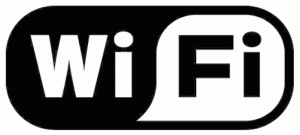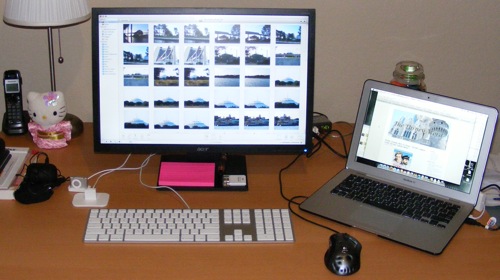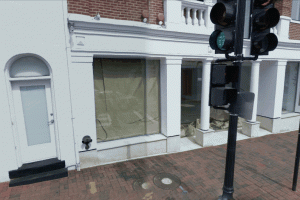I saw this new “iPOOd” trowel at a Virginia REI store. Like an actual iPod, it is lightweight and has very few buttons. Unlike an iPod, it is good for digging.
Wireless Draft N Compatability Issues

There are many flavors of wireless networking. Most common are 802.11B, 802.11G, and now 802.11N (Draft). 802.11N is “draft” because the standard has not yet been formalized, despite the sale of draft-N devices for over a year. For most people, this won’t cause a problem. But hitches do come up.
Draft N Works, Usually
When I was recently setting up a D-Link draft-N router with a MacBook Pro, I noticed that the wireless connection would drop regularly or show a connection but be unable to receive/transmit. This was due to the incompatable N implementations. The solution is to go into the router settings and switch it to only using B/G. In most cases, I have found draft N devices to work without any issues.
Future of WiFi Standards
The 802.11N standard is expected to be finalized by the IEEE LAN/MAN Standards Committee (IEEE 802) in November 2009. Then all the current draft-N manufacturers promise a firmware upgrade that will make them interoperable. Of course by November 2009, we might be looking at buying new draft wireless standards, as described by PC Magazine:
802.11s, a mesh networking specification that’s been on the drawing board since September 2003. (It probably won’t be final until September 2010.) Laptops and other devices with 11s support will function as mesh points (or MPs) and form links with each other, allowing packets of data to skip from device to device across the network as needed. Mesh has been around for a while in many proprietary forms, and is important not only because it can extend a network’s range but also because it has self-configuring abilities: Mesh devices can move about without impacting overall performance. In such a network, data will hop around from mesh point to mesh point along the shortest path to where it needs to go. Actual 11s is already in use in at least one product: the One Laptop per Child project’s XO laptop uses it to communicate with XS school servers, in some tests over distances as great as 2km with 802.11s data hops from device to device.
802.11u, called “InterWorking with External Networks,” will provide a Wi-Fi device with methods of connecting securely to a network, based on the external network’s type. For example, if you have access to the cellular connection that provides Internet access to the Wi-Fi router on a bus, 11u will keep that connection secure. It will also allow a Wi-Fi device to discover more information about that external network, such as whether it’s free of charge or not. 11u could be published by March of 2010.
802.11z “Direct Link Setup” is the 802.11 Working Group’s take on improving ad hoc connections, at least for business users. It’s entirely unrelated to what the Wi-Fi Alliance is doing for device-to-device communication. 11n allows two laptops that would normally communicate on a secure network to form a P2P connection to talk to one another exclusively. This happens only after they’ve authenticated security credentials through an AP. It’s a super-secure ad hoc that requires the right security setup.
See a full list of 802.11 standards and approval timelines from IEEE.
Apple Store Rebuked For Georgetown, Again
We wrote earlier about the Apple store design for Georgetown being rejected. The Washington Post writes that it just happened again:
An architectural review board yesterday ordered Apple to redraw plans for a store in Georgetown, the fourth time it has rejected the company’s submission.
The Old Georgetown Board told Apple’s architect that it is eager for the store to open on Wisconsin Avenue. But the three members, all architects, expressed disappointment that Apple keeps proposing a design that they have criticized.
In the latest rendering, Apple proposed a storefront that is a 35-foot-wide pane of glass with a door. During previous rounds, the board said that was inconsistent with neighboring properties’ detailing and bay windows. “We’re frustrated a little bit because we haven’t gotten a response to our fairly consistent request,” board member David Cox told Apple’s architect, Karl Backus.
Backus assured the board that Apple is not “purposefully ignoring your suggestions,” although he noted that a glass expanse is standard for many of the company’s storefronts, symbolizing its belief in transparency. Still, he said he would return with a new design proposal that would incorporate the board’s suggestions.
Apple’s struggles to win the board’s support have fueled concerns among merchants and city officials over how long the company is taking to open a store that it began planning at least two years ago.
Neil O. Albert, deputy mayor for planning and economic development, said in a statement that “we’re extremely disappointed with today’s decision.”
“The community and the Fenty administration are very supportive of this retailer opening its Georgetown store,” he said. “I’ll move quickly to convene separate meetings with the Old Georgetown Board and Apple representatives to reach a consensus design.”
Amy Bessette, an Apple spokeswoman, said in an e-mail that the company remains committed to “bringing the unique Apple retail experience to Georgetown.”
In 2007, Apple paid more than $13 million for the three-story building on Wisconsin Avenue. The building is 24 years old but it is within a historic district with buildings more than 100 years old.
ad_iconApple plans to raze the building and put up a store, joining 251 retail outlets it has around the world, including five in the Maryland and Virginia suburbs.
But first it must win the approval of the Old Georgetown Board, which is overseen by the U.S. Commission of Fine Arts.
Apple submitted its first renderings to the board in September 2007, a two-story building with five windows across the second floor and an expansive show window. The board told Apple that the ground-floor window was out of scale with neighboring storefronts.
After the Old Georgetown Board asked for revisions, Apple returned with two more modern versions, and both were rejected.
The renderings the company displayed yesterday were largely indistinguishable from the first round.
At yesterday’s hearing, Stephen J. Vanze, an Old Georgetown Board member, told Apple’s representatives that he was feeling pressure at home to approve Apple’s plans.
“My daughter said, ‘We better get an Apple store in Georgetown,’ and I better make her happy,” he said.
But Vanze reminded the audience that the board’s sole mission is to “review design issues.”
“For us to do our job, we need to protect the street,” he told Apple’s architect. “We want to help you do this. Again, we ask you to modulate the glass.”
After the meeting, Backus said he hoped to return with a new design next month. “We don’t want to drag this out further,” he said.
While the District of Columbia still has no Apple stores, there are many Apple stores in the D.C. metro area in nearby Virginia (two stores in Arlington, one in Fairfax, and one in McLean, VA) and Maryland (two stores in Bethesda and one in Columbia, MD).
MacBook as your Desktop
It used to be you needed both a laptop for travel and a desktop for more power. But nowadays laptops are a lot more powerful than they used to be and the cream of the crop are the MacBooks. With an external monitor, keyboard, mouse, and usb hub, you can easily switch from laptop mode to desktop mode with any MacBook by just plugging in 2 cables.

External Monitor
You can get an excellent big screen LCD for a lot cheaper than you used to. You can hook it up to your MacBook, MacBook Pro
, or MacBook Air
with a DVI adapter and the exact adapter varies based on your model. The original MacBook Air was nice enough to come with this adapter. The new Airs and MacBooks do not so they’ll cost you an extra $30. One of the best value monitors you can get is the Acer V223-WBD 22″ LCD
(pictured above with MacBook Air). Macs are smart when it comes to detecting external monitors so you can just plug in and the new monitor should almost immediately become an extended screen once powered on. When you unplug, the Mac is similarly smart and goes back to single screen mode.
Keyboard and Mouse
Since we’re talking about Macs, the best keyboard to go with is the slim Apple Keyboard. Pretty much any usb mouse will do but I highly recommend the Logitech MX518 Mouse
. It is technically a gaming mouse but I just love it for the precision and extra buttons on the side that can be setup to quickly access expose.
USB Hub
A terrific USB hub is the D-Link 7-port USB hub. 7 ports may sound like a lot but with a keyboard, mouse, ipod/iphone cable, and external hard drive, you’re already mostly full. With the hub, all your USB devices are plugged into this and then you just have to plug in one USB cable to your MacBook.
External Hard Drive
One area where laptops are still greatly lacking is hard drive space. If you don’t have much in iTunes or iPhoto, you might be fine with just a 80-250GB laptop hard drive. If you need more space, you’ll need to get an external drive such as the Western Digital 750GB My Book. To move your iPhoto Library to your external drive, copy the “iPhoto Library” file from your Pictures directory to your external drive. The next time you start iPhoto, hold down the option key and you’ll be given a choice to select where your iPhoto Library is. Once you select the library on the external drive, you won’t have to hold down option again. The only downside is you will need your external drive hooked up to see the library. Similarly, you can copy your Music directory to the external drive and then open iTunes preferences and go to the Advanced tab. There you can change the iTunes Music folder location to point to your external drive Music directory. You should only do these things if you need to. Often you might just have to move just iPhoto or just iTunes based on your usage.
Time Machine
If you plan to use Time Machine, which we recommend, you should consider partitioning your external drive into 2 partitions using Disk Utility which can be found in the Utilities directory under Applications. Select your drive on the left of Disk Utility and then select the Partition tab. You can slide the separator up and down to adjust the partition sizes. We recommend giving yourself room to grow for your data such as iPhoto and iTunes and then leave whatever else for Time Machine to utilize. When you are happy with your settings, click Apply. You can then setup Time Machine to use 1 partition and put your iPhoto and iTunes data on the other. The reason you need to setup 2 partitions is because Time Machine will continue to grow until it’s partition is full so you need to ensure your data has a separate area to grow.
Summary
With a little planning, you can have all the benefits of a laptop and a desktop with just one laptop. Just plug in a USB cable to activate all your USB devices. Plug in your external monitor to use your desktop sized LCD. These principles can also be applied to a Linux or Windows laptop although not with such ease. The performance of the MacBook line is what makes them ideal candidates for desktop-power uses such as photo editing. If you have a MacBook, you likely don’t need a desktop and just buying an external LCD is a very cheap desktop solution.
Problems Opening an Apple Store In D.C.
 According to the Georgetown Current, Apple has been trying to open a new store in Georgetown since 2007 but has been having problems getting its designs through local review.
According to the Georgetown Current, Apple has been trying to open a new store in Georgetown since 2007 but has been having problems getting its designs through local review.
Apple Inc. claims design geeks as well as computer snobs among its fans, and the company’s storefronts are hallowed ground for those who worship form as much as function.
But Apple’s design credentials seem to hold little sway in Georgetown. Although the company has owned a Georgetown location at 1229 Wisconsin Ave. for more than a year and has approval to demolish the existing structure there, D.C. has yet to get its first Apple store. Moreover, recent delays suggest the wait is far from over.
At its Dec. 2 meeting, the Georgetown advisory neighborhood commission rejected the third consecutive proposal from the California-based store, and the Old Georgetown Board did the same at its meeting two days later.
Planners had hoped the third time would be the charm: “Steve saw this design and really loves it,” said project manager Carrie Johnson, referring to Apple founder Steve Jobs.
Commissioners disagreed with Jobs and claimed the design – a glass first story with a solid-stone upper facade punctuated by a large window shaped like Apple’s logo – would not fit into Georgetown.
Old Georgetown Board members agreed, said board spokesperson Tom Luebke. “The board felt that the design turned the building into a billboard,” he said.
Other board criticisms have been constants since September 2007, when Apple presented its first design, a glass lower story and an upper story that featured punched windows.
“That first time, like every time after, it was a question of scale,” said Luebke. The board wanted something to break up the unrelieved expanse of glass, but Apple returned in the summer of 2008 with an all-glass facade.
“The board wanted something less autonomous, something that supports the historic district,” said Luebke. And again, there was the question of scale.
Although the complaint that the most recent iteration was “too modern” did surface at the neighborhood commission meeting, the moreauthoritative Old Georgetown Board told Apple that a “modern treatment is possible,” according to Luebke.
“They’re not against modern design,” he said of the board.
Another worry has been the one-story approach to the building, formerly the site of a French Connection UK store.
“It didn’t seem that one-story occupancy is an enlightened idea for smart growth in Georgetown,” said Luebke.
Apple Inc. did not return calls for comment.
The brand has had success placing stores in historic and culturally important spots other than Georgetown. A brief survey of existing storefronts, however, shows that Apple’s proposals for the D.C. site more closely echo newer, suburban Apple stores than, for example, the company’s stores on Regent Street in London or in SoHo in New York City.
Those latter stores’ facades, however, were historically protected and therefore retained, while the Wisconsin Avenue site will be demolished.
But Apple will somehow have to adjust its design to its surroundings if it wants to proceed, said Luebke. “So far,” he said, “there has been very little context of the historic district.”
While we wait for the first Washington D.C. store to open, there are many other Apple stores in the D.C. metro area in nearby Virginia (two stores in Arlington, one in Fairfax, and one in McLean, VA) and Maryland (two stores in Bethesda and one in Columbia, MD).

